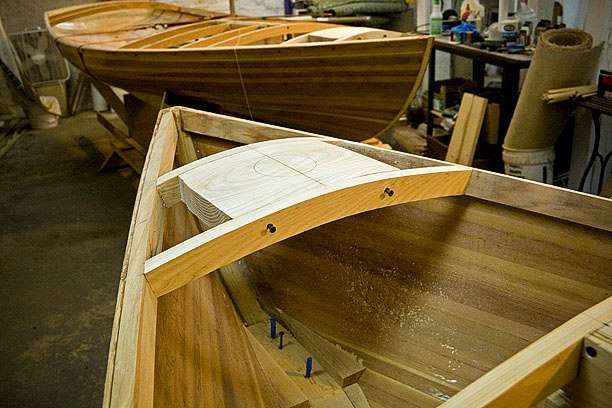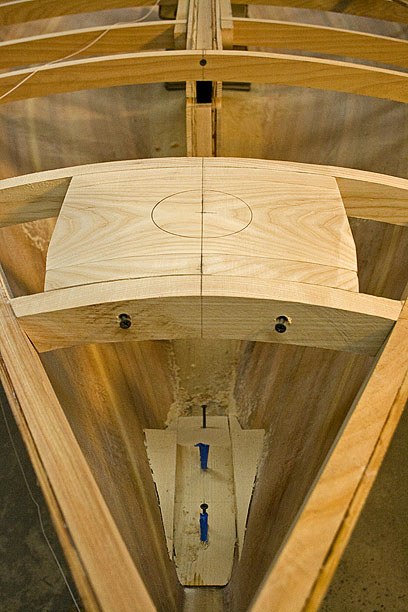Finished Mast Partner, plug below
Back in the saddle.
Finally had a good weekend. The cedars still wear dirty white socks of snow on their feet, but just beyond their shadows the crocus are blooming. At least there was no new snow. The humidity problem hasn’t improved much, but with warm days ahead, and rain coming, that should change soon. Until then there’s plenty to do.
The mast partners are positioned in precise but rather vague spots above the mast steps. The partner frames don’t fall directly over stations, so there are no real measurements to go by for either their shape or location. There’s a fair amount of guess work and reshaping and checking with a batten until you get it right. I had to make five to get four good ones.
If the mast is a lever, the partners are the fulcrum, so a lot of force is applied on this spot when under sail. To handle that stress, these pieces are made of ash instead of cedar, and cut thicker than the other beams.
I spent a lot of time laying out where the hatches will go while deciding where to locate these beams, since they will also form the forward frames for the hatch openings. Beyond that it’s pretty much guess work.
The location of the hole for the mast, though, has to be quite precise. Both Barto and Chapelle show the center of the mast step exactly 1” forward of the center of the hole in the deck. This offset determines the rake of the mast, and ultimately the balance of the rig. Odd thing is, neither specifies the distance between the mast step and the mast partner, and that figure is necessary to get the angle right. Being a quarter inch off here translates to 3 inches off at the top of the mast. Fortunately, since my steps will be adjustable forward and back by an inch each way, I’ll have a way to correct for a small error here. All I have to do is get close and center them side to side. To do that I re-leveled the hulls and dropped a plumb line, then measured the 1” offset along the centerline.
Barto’s plans call for the actual partner, or mast bed, to be made of ash planks 7” wide, 3/4” thick, and over 12” long. A big strong piece of wood. But that’s assuming a daggerboard with no hatch. To get a centerboard, and a hatch opening of useful size, means reducing that foot by half. I was afraid that wouldn’t leave enough wood around the hole to keep it from splitting. So I turned the planks sideways to get 7” x 9 1/2” blocks and glued them up out of 2” thick stock. This will make fairly beefy partners, even after shaping. I then shaved them to fit tight between the beams where they’ll eventually be glued and screwed, getting an extra lamination from of the beams.
Terri was in and out taking pictures during the process, so there are a few photos of the furrowed brow in action.
Once the blanks are screwed in place, the crown of the deck can be traced from the profile of the beams, then they get shaped with a grinder and belt sander.
I used the router again to cut clean holes in this thick, hard wood. Turns out driving a finish nail in the center of the block, for the router to pivot around, made just the right size hole.
Emily was home on Spring Break with Little Buddy to keep me company, and to play in the sawdust.
So this step is basically done. Beams on Saturday, Partners on Sunday. Pretty good weekend. Next up is Breasthooks.
Tonight we heard a chorus of peepers singing in the dark, coming from the pond in the back field. First time this year. Spring is almost here.
melonseed skiff, mellonseed skiff, melon seed, mellon seed

















Nice to see some progress! Looking forward to seeing this all come together.
-T
Monday, March 15, 2010 – 02:37 PM
Hey T, how was HI?
Tuesday, March 16, 2010 – 11:34 PM
Just stumbled upon your site! Love your builds! I’m muttering back and forth between the Melonseed and a Barnegat bay sneak box ( I grew up on Barney) Now residing in Newport News, VA, I was wondering were your launch site might be?
Tuesday, March 16, 2010 – 10:44 PM
Glad you like it, though i do wish it was done by now.
Not sure yet where splash down will be, but somewhere in Tidewater almost certainly. I hope to make it up to Barnegat before long, maybe next summer. The Melonseed seems to take the best of both the Sneak Box and another great Jersey boat, the Sea Bright beach skiff. They used to say a Sneak Box needed so little water it could follow a mule up a wet path, but the skiff could handle surf and choppy water much better. Guess it depends on where you plan to sail as far as which boat is best. Most of where I’ll be is in between, so a Melonseed seems just right.
Tuesday, March 16, 2010 – 11:42 PM
Well, please keep us posted…I would love to see your skiff in action…I’m supposed to go to Forked River, NJ in April to pick up a sneakbox…as for Seabrite skiffs, I used to row them @ Island Heights, what a HEAVY boat! My wife loves the look of the Melonseed, I like that its a touch larger than a BBSB, and can keep you dryer in rougher conditions…
Wednesday, March 17, 2010 – 08:30 PM